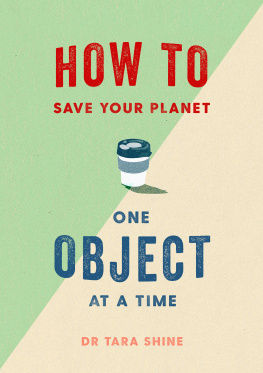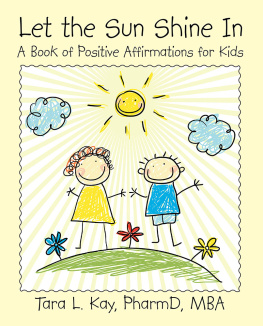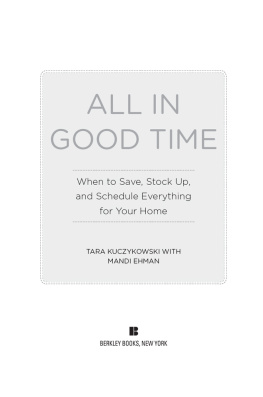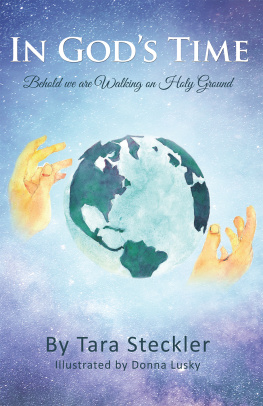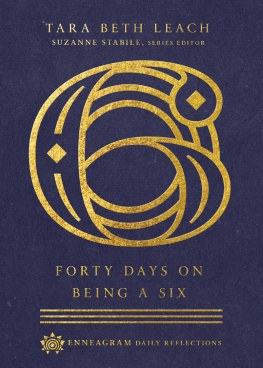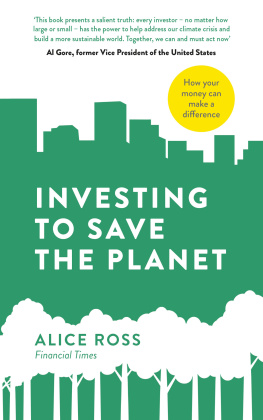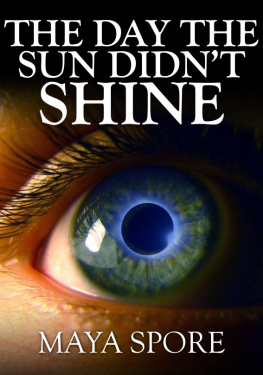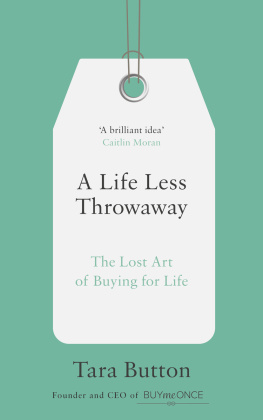Tara Shine - How to Save Your Planet One Object at a Time
Here you can read online Tara Shine - How to Save Your Planet One Object at a Time full text of the book (entire story) in english for free. Download pdf and epub, get meaning, cover and reviews about this ebook. year: 2020, publisher: Simon & Schuster UK, genre: Home and family. Description of the work, (preface) as well as reviews are available. Best literature library LitArk.com created for fans of good reading and offers a wide selection of genres:
Romance novel
Science fiction
Adventure
Detective
Science
History
Home and family
Prose
Art
Politics
Computer
Non-fiction
Religion
Business
Children
Humor
Choose a favorite category and find really read worthwhile books. Enjoy immersion in the world of imagination, feel the emotions of the characters or learn something new for yourself, make an fascinating discovery.
- Book:How to Save Your Planet One Object at a Time
- Author:
- Publisher:Simon & Schuster UK
- Genre:
- Year:2020
- Rating:5 / 5
- Favourites:Add to favourites
- Your mark:
- 100
- 1
- 2
- 3
- 4
- 5
How to Save Your Planet One Object at a Time: summary, description and annotation
We offer to read an annotation, description, summary or preface (depends on what the author of the book "How to Save Your Planet One Object at a Time" wrote himself). If you haven't found the necessary information about the book — write in the comments, we will try to find it.
How to Save Your Planet One Object at a Time — read online for free the complete book (whole text) full work
Below is the text of the book, divided by pages. System saving the place of the last page read, allows you to conveniently read the book "How to Save Your Planet One Object at a Time" online for free, without having to search again every time where you left off. Put a bookmark, and you can go to the page where you finished reading at any time.
Font size:
Interval:
Bookmark:

An article in the UKs Guardian newspaper
in January 2018 stated that considering the
number of cups of tea that are brewed every
year in the UK, the amount of polypropylene
used to seal the bags could be in the region of
150 tonnes of plastic this accumulated waste
may be contaminating food waste compost
collections, going to landfill or escaping into
the environment.
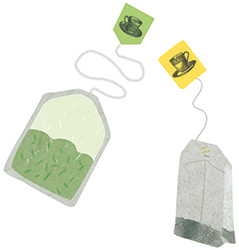
__________
TEA BAG
Whether you like strong builders tea or prefer a more delicate oolong or Earl Grey tea, one survey showed that 68 per cent of people in the UK drink two or more cups a day. Tea is an essential part of many peoples daily life, helping them to wake-up, relax and unwind.
It is estimated that tea was first used as a medicinal drink in China in 2737 BC. China is the largest producer of tea followed by India and Kenya. But its Ireland that drinks the most tea per capita, followed by the UK.
THE IMPACTS
Tea bags are typically made from paper and sealed with polypropylene, a plastic a fact that explains why gardeners reported very slow decomposition of tea bags in their compost heaps. A 2010 Which? gardening study in the UK revealed tea bags from top manufacturers were only 7080 per cent biodegradable. In some tea bags, plastic is contained in the mesh of the bag itself as well as in the glue that holds it together. Given the increase in public awareness about plastic, a number of tea producers have set targets for removing the plastic from their tea bags.
The environmental footprint of a tea bag isnt just down to the plastic its also the resources that go into growing, processing and transporting tea. A 2012 study revealed that over 300 litres of water are required to grow enough tea for 25 tea bags and when grown in water-scarce areas, tea places a stress on groundwater supplies.
A 2017 study published in the Oxford Research Encyclopedias states that the intensive, monoculture production of tea has a high impact on the environment. It typically requires the use of pesticides and inorganic fertilisers that create environmental hazards, cause water pollution and threaten biodiversity. The repeated application of fertilisers and herbicides also contributes to soil degradation, and the acquisition of new land for tea growing contributes to deforestation and habitat loss. The processing (drying and fermenting) and transport of tea relies on the burning of fossil fuels, which contributes to climate change. So, a cup of tea with zero impact is not possible but it is possible to make choices that are better for you and the environment.
zTHE FIRST TEA BAG
The tea bag was invented by accident in America in 1908 by Thomas Sullivan, a New York tea merchant. He sent samples of tea to his customers in small silk bags; they assumed the bags were to be used in the same way as the metal infusers to make tea. Sullivan then refined his approach to use gauze rather than silk and began commercial production in the 1920s. However, they didnt become popular until the 1950s due to wartime materials shortages. Once they hit the shelves, tea bags were a winner with tea drinkers due to their convenience. In the early 1960s, tea bags made up less than 3 per cent of the British market rising to 96 per cent of the market by 2018.
WHAT YOU CAN DO
- Use loose tea leaves and make a pot of tea many people say this makes the best cup of tea because brewing tea in its loose-leaf form allows the hot water to infuse the whole leaf, producing the freshest, fullest flavour possible. Buy and use a metal tea infuser if you just want to make one cup of tea at a time.
- Buy plastic-free tea bags in minimal packaging. Ideally choose certified compostable tea bags and put them with your food waste in a brown (organic) bin. Dont expect your home composter to be able to cope with tea bags - they break down more slowly than food waste.

- Avoid overpackaged and individually wrapped tea bags.
- Look out for Rainforest Alliance or fairtrade certified tea to ensure that the tea has been produced to high environmental standards meaning less impact on the environment.
- Uphold standards by choosing fairtrade or ethical tea partnership certified tea such products provide better working conditions and pay for people working all along the supply chain from the growers and pickers to the factory workers.
- Choose certified organic tea that is grown and produced without synthetic fertilisers, pesticides or herbicides, so that it is better for biodiversity and protects the health of the growers and pickers.
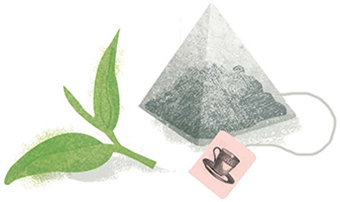

THE FIRST PLASTIC-FREE TEA BAG
One company working hard to make sure all their tea bags are plastic free,
as well as ethically sourced, is teapigs. Nick Kilby and Louise Cheadle set up teapigs
to bring more varieties of whole-leaf tea to tea lovers.Their quest for flavour and
quality also led them to care about the environmental footprint of their tea and
the lives and wellbeing of the farmers that grow it.

From the start, the company put an emphasis on whole-leaf tea so no standard tea
bags. Instead they use pyramid-shaped tea bags that they call tea temples to hold
their tea. These temples are made from corn starch, which is biodegradable, as is
the string, and the label is made from paper printed with vegetable oils.
The temples are heat sealed, so theres no plastic glue either.

The company is transparent about what biodegradable means for their
tea and dont recommend putting them in your household compost
as they will take too long to break down, but they can go in with your
food waste for industrial composting.

Packaging-wise, their cardboard cartons are made from FSC-certified cardboard,
which is recyclable, and the clear, inner bags are made of a material called
Natureflex. It might look like a plastic bag but this cellulose product is compostable
in a home or an industrial composter. The company also makes loose tea in
aluminium cans, which can be recycled or repurposed.

Best of all, teapigs provides clear, honest information to their customers about their
impact on the environment and how they work with their tea-growing communities.

In 2018, teapigs were the first tea brand to be awarded the Plastic Free Trust Mark
certifying that the product and the packaging are plastic free. The certification is
awarded by A Plastic Planet, a not-for-profit organisation based in London.
THE REAL PRICE OF COFFEE
I love coffee and drink it every day. I am part of a massive market for a commodity that is traded so frequently that the price changes every three minutes. Yet, almost 61 per cent of coffee growers are selling their coffee at a loss.
Font size:
Interval:
Bookmark:
Similar books «How to Save Your Planet One Object at a Time»
Look at similar books to How to Save Your Planet One Object at a Time. We have selected literature similar in name and meaning in the hope of providing readers with more options to find new, interesting, not yet read works.
Discussion, reviews of the book How to Save Your Planet One Object at a Time and just readers' own opinions. Leave your comments, write what you think about the work, its meaning or the main characters. Specify what exactly you liked and what you didn't like, and why you think so.

